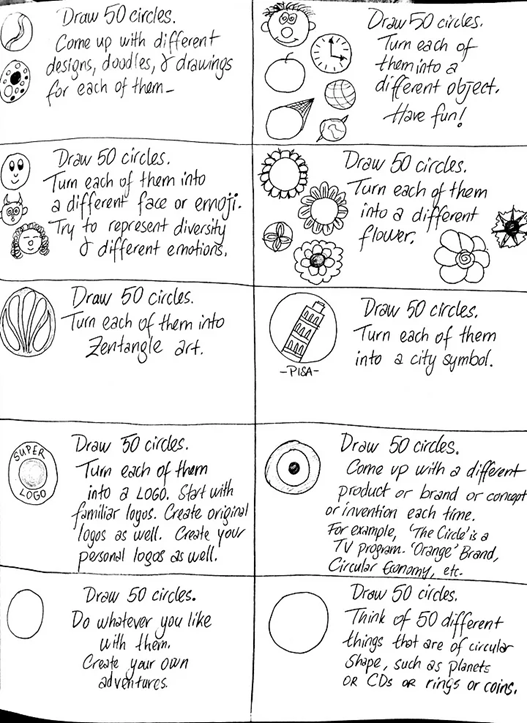Introduction
The 30 Circles Technique is a creativity exercise that involves drawing 30 circles on a piece of paper and then using them as a starting point to generate new ideas or solve a problem. Each circle can represent an element, concept, or idea, and the goal is to fill all the circles with something that is related to the task at hand.
30 Circles
The 30 circles technique is also known by a few other names, including 30 Circles Challenge, 30 Circles Exercise, 30 Circles Method and 30 Circles of Ideas.
Description
What is this technique/tool about
The 30 Circles Technique is a creative thinking exercise or tool that is used to generate new ideas, explore possibilities, and solve problems. The technique involves drawing 30 circles on a piece of paper and then using each circle to brainstorm a different idea or concept related to the task at hand.
The purpose of the technique is to encourage divergent thinking, which is the ability to generate a wide range of ideas and perspectives. By using the 30 Circles Technique, individuals can break free from mental blocks, explore new possibilities, and think creatively.
For which purposes is it used (why in your secondary school teaching)
The 30 circles technique is used for various purposes, including:
- Idea generation: The technique can be used to generate new ideas for a project, essay, or presentation. By using the circles to brainstorm ideas, students can explore different possibilities and perspectives related to the topic.
- Problem-solving: The technique can be used to solve problems in various subjects, such as math, science, or social studies. By using the circles to break down a problem into smaller parts and brainstorm solutions, students can enhance their critical thinking and analytical skills.
- Creativity and design: The technique can be used in art, design, or technology classes to stimulate creativity and generate new design ideas. By using the circles to sketch out different design elements, students can explore different shapes, colors, and patterns.
- Teamwork and collaboration: The technique can be used in group projects to encourage teamwork and collaboration. By working together to fill out the circles with different ideas and perspectives, students can learn to respect and value each other's contributions.
Limitations
While the 30 circles technique can be a useful tool for problem-solving and decision-making, it also has some limitations. These include:
- Potential for repetition: The technique involves generating multiple ideas or solutions, which can sometimes result in the repetition of similar or overlapping ideas. This can limit the effectiveness of the exercise and reduce the quality of the outcomes.
- Limited applicability: The technique may not be suitable for all subjects or topics, and it may not work for all learning styles or preferences. It is important to consider the specific needs and learning objectives of each student before using the technique.
- Need for time and resources: The technique requires time and resources to complete, which can be challenging in a busy classroom environment with competing demands on students' attention and time.
How to implement these technique/tools
The implementation of the 30 circles technique typically involves for each phase different steps as follows.
Preparation, before the section:
- Identify the problem or topic: Determine the problem or topic that needs to be addressed or explored. This could be a creative project, a problem to solve, or a subject to study.
- Set the goal: Define the goal or objective for using the 30 Circles Technique. What do you hope to achieve by using this technique? What are the expected outcomes?
During the section:
- Prepare materials: Provide each student with a piece of paper and a pen or pencil.
- Draw 30 circles: Instruct participants to draw 30 circles on the paper, evenly spaced.
- Brainstorm ideas: Instruct participants to fill in each circle with a different idea related to the problem or topic. Encourage them to think creatively and divergently.
- Share and discuss: Once participants have completed filling in the circles, have them share their ideas with the group. Encourage discussion and feedback on the different ideas generated.
- Evaluate and select: Evaluate the ideas generated and select the most promising ones. Determine how these ideas can be used to address the problem or topic.
Follow up after the section:
- Implement the selected ideas and monitor their effectiveness. Use the insights gained from the 30 Circles Technique to refine and improve the solutions over time.
Examples and/or testimonials
Using the 30 circles in education can support students' performance and engagement. A few 30 circles technique made as examples are given below.

Figure 1. An example of the 30 circles (Source: https://medium.com/journal-of-curiosity-imagination-and-inspiration/how-can-you-use-circles-to-develop-your-creativity-409e04d01d30)

Figure 2. An example of the 30 circles(Source: https://www.nsta.org/science-scope/science-scope-septemberoctober-2021/simple-sketch-tool-foster-creativity-science)
Tools needed
To apply the 30 circles technique face to face, it needs tools such as whiteboard, paper, board marker and pen. Online conferencing tools and online design tools are used in online or hybrid applications. Examples of these tools are: Diagrams.net, MindMeister, Miro, Canva, Zoom, Teams, Meet etc.
Resources
Links:
- https://en.dinamicasgrupales.com.ar/activities-and-games/creative-thinking/the-30-circles/
- https://web.stanford.edu/group/sdgc/cgi-bin/ycisl/?p=1859
- https://hbr.org/2013/11/three-creativity-challenges-from-ideos-leaders
Videos:
< Go back to toolkit